Foreword
Serious violence affects the lives of individuals, families, and communities. The impact can be felt whether you are a victim, know a victim or a person who has caused harm, witnessed an incident personally, or seen reports of violence in the media.
No single agency can reduce serious violence or it’s impacts. Safer Torbay is committed to continuing to strengthen our partnership approach to violence, which includes working with our communities who are at the heart of our response.
Our Strategy recognises the importance of early intervention to tackle the root causes of violence and preventing individuals from being impacted by it in the first place. This is particularly vital for our children and young people to stop the cycle of violence and provide long-term sustainable change.
Our Strategy outlines how we will work in partnership with our communities using 6 key principles to underpin how we understand and respond to the causes of violence locally, recognising and building on our existing strengths and working together to understand and overcome our challenges.
Although prevention is a key focus of our Strategy, it is recognised that the causes of violence are multi-faceted and complex. As such our approach enables an end-end approach from prevention through to targeted responses. This is reflected in our priorities and supports the development of long-term sustainable approaches to reducing violence and supporting communities across Torbay to both be and feel safe.
Safer Torbay would like to thank everyone who has contributed to the development of this Strategy. We look forward to continuing to work together over the coming years to reduce serious violence and its impact in Torbay.
Tara Harris, (Divisional Director for Community and Customer Services, Torbay Council)
Chair, Safer Torbay
Introduction
Although over the last decade evidence shows that overall crime in England and Wales has consistently fallen, serious violence, such as homicide, knife crime and gun crime have risen in almost all police force areas.
Nationally these increases have been accompanied by a shift towards younger people becoming both victims to and causing harm.
As a result of this the Government developed the national Serious Violence Strategy 2018[1] and through the Police, Crime Sentencing and Courts Act 2022[2] (PCSC Act) has introduced the Serious Violence Duty (the Duty).
The Serious Violence Strategy 2018 advocates a clear balance between prevention and law enforcement. It stresses the importance of early intervention to tackle the root causes of violence and steering young people away from crime in the first place, whilst ensuring that the police have the tools and support, they need to tackle violent crime.
Addressing serious violence is not a single agency responsibility. To effectively and sustainably tackle violence and its impact we must work in collaboration with all local partners across the statutory and non-statutory sectors. Most importantly we must work with our communities who will be at the centre of our response.
For an effective long-term approach to be embedded, we need to fully understand our local needs, including the risk factors and drivers that exist in Torbay that increase the likelihood of an individual becoming involved in serious violence.
This strategy provides a partnership framework that enables an end-to end approach, from prevention to targeted approaches. It focuses on continuing to strengthen our whole partnership and trauma informed response to need and builds on what works in Torbay and the excellent work already taking place across the partnership.
Our strategy recognises the need for an evolving approach as our knowledge and responses to violence improve. This ensures a dynamic, evidence based and effective approach to bringing an end to serious violence in Torbay.
Serious Violence Duty
The PCSC Act 2022 introduced the new multi-agency Serious Violence Duty (the Duty).
The Duty requires specified authorities to work together to prevent and reduce serious violence, including identifying the kinds of serious violence that occur in the area, the causes of that violence (so far as it is possible to do so), and to prepare and implement a strategy for preventing and reducing serious violence in the area.
The aim of the Duty is to encourage organisations to share information, data and intelligence, and work collaboratively rather than in isolation to tackle serious violence.
The Partnership Approach
In Torbay the mechanism for the delivery of the Serious Violence Duty is through the Safer Torbay Partnership (Torbay’s Community Safety Partnership).
The Duty requires a multi-agency approach to identifying and addressing serious violence. Central to this is working with communities to ensure that all development and approaches reflect the voices and lived experience of the communities they intend to support.
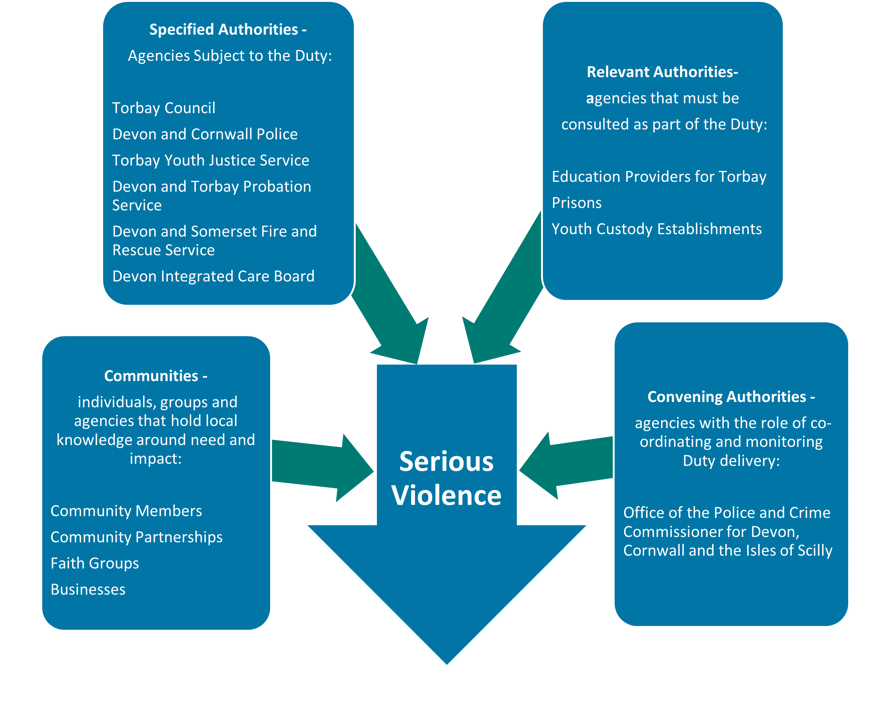
Defining serious violence
The Serious Violence Duty – Preventing and reducing serious violence Statutory Guidance for responsible Authorities - December 2022’[3] (‘the Statutory Guidance’) is clear that specified authorities need to work together to identify the kinds of violence that occur in their local area to effectively respond.
The PCSC Act does not define serious violence for the purposes of the Duty. Instead, in defining violence locally specified authorities must take into account the factors outlined in s. 13(6) of the PCSC Act:
- the maximum penalty which could be imposed for any offence involved in the violence;
- the impact of violence on any victim;
- the prevalence of violence in the areas, and
- the impact of the violence on the community in the area
S.13 of the PCSC Act makes it clear that violence is not limited to physical violence against the person and can include domestic abuse, sexual violence, violence against property and threats of violence as other examples. The key is to consider the broad range of crime types (with the notable exception of terrorism) and critically consider, using the factors above, whether the volume constitutes serious violence in the local area.
This flexibility means that local areas can consider new and emerging forms of serious violence as they develop and are identified using local partnership and community data and intelligence.
The Statutory Guidance also states that specified authorities should:
‘include a focus on public space youth violence including homicide and violence against the person which may include both knife and gun crime, and other areas of criminality where serious violence or its threat is inherent, such as county lines drug dealing’.
The Torbay Definition
Safer Torbay aims to develop a long-term sustainable approach to violence in Torbay. For this to be successful it is recognised that the scope and definition of violence in Torbay needs to support responses to the current identified needs as well as be flexible to support the partnership to recognise and respond to new and emerging forms of violence.
As such the definition of Serious Violence in Torbay is:
An act that causes or intends to cause physical and or psychological harm or fear of harm, to a person or community.
.
What does violence look like locally?
In order to effectively address serious violence, we need to fully understand our local violence profile, including the risk factors and drivers that exist in Torbay that increase the likelihood of an individual becoming involved in serious violence. To develop this understanding and in line with Statutory Guidance, Safer Torbay has undertaken a strategic needs assessment.
Considering the factors outlined in s.13(6) of the PCSC, the requirements of the statutory guidance and critically considering the violent offences that have a significant impact in Torbay, the strategic needs assessment focused on the following crime types:
- Violence With Injury
- Robbery
- Possession of Weapons
- Drug Offences
- Homicide
- Domestic Abuse and Sexual Violence
- Stalking & Harassment
Assault Related Injuries Data (ARID) which shows data in respect of patients who have attended Accident and Emergency Departments across Devon and Cornwall as a result of injuries sustained due to assault has also been included.
In line with the requirements in the guidance to include a ‘focus on public space youth violence’ we have taken an in-depth look at the under 25 cohort data in relation to these offence types.
During the Covid-19 pandemic crime rates reduced both nationally and locally. As such, to ensure that a relevant and informed view of the data was developed, we have collated and analysed data from across the financial years 2019/2020, 2020/2021. 2021/2022. Including 3 full years of data that spans the pre to post pandemic time period gives us a better sense of trends and needs. The first 7 months of data for 2022/2023 has also been included to give an indicative view.
- 6,227 separate incidents occurring across Torbay that have had Devon and Cornwall Police involvement.
- 4,772 of these incidents identified an offender/suspect responsible for the incident.
- 17% of these offenders/suspects were aged under 18.
- 20% of these offenders/suspects were aged 18 - 25.
- 36% of incidents recorded were Alcohol Related
- 71% of offenders were male.
- Robbery incidents reduced significantly during the pandemic; however, trend would indicate that incidents within 2022 will be at a similar level to those pre pandemic.
- There have been 331 separate incidents occurring across Torbay that have had Devon and Cornwall Police involvement.
- 151 of these incidents identified an offender/suspect responsible for the incident.
- 19% of these offenders/suspects were aged under 18.
- 30% of these offenders/suspects were aged 18 - 25.
- 18% of incidents recorded were Alcohol Related
- 85% of offenders were male.
Possession of Weapons April 2019-October 2022:
- There have been 503 separate incidents occurring across Torbay from April 2019 to October 2022 that have had Devon and Cornwall Police involvement.
- Possession of Article with Blade or Point accounted for 48% of total incidents
- 457 of these incidents identified an offender/suspect responsible for the incident.
- 17% of these offenders/suspects were aged under 18.
- 21% of these offenders/suspects were aged 18 - 25.
- 22% of incidents recorded were Alcohol Related
- 86% of offenders were male.
Drug Offences 2019-October April 2022:
- There have been 1,861 separate incidents occurring across Torquay, Paignton and Brixham from April 2019 to October 2022 that have had Devon and Cornwall Police involvement.
- 1,851 of these incidents identified an offender/suspect responsible for the incident.
- 10% of these offenders/suspects were aged under 18.
- 30% of these offenders/suspects were aged 18 - 25.
- 11% of incidents recorded were Alcohol Related
- 85% of offenders were male.
Domestic Abuse and Sexual Violence April 2019-October 2022:
- Domestic Abuse & Sexual Violence crimes decreased by 2% during the pandemic. Within 2021/22 volumes returned to pre pandemic levels. Trend would indicate that crimes within 2022/23 will increase by approx. 7% compared to 2021/22.
- Alongside Domestic Abuse Crimes, Devon & Cornwall Police also attended incidents relating to Non-Crime Domestic Abuse. For the period stated above there were a total of 4,185 Non-Crime Domestic Abuse incidents
- There have been 8,656 separate crimes occurring across Torquay, Paignton and Brixham from April 2019 to October 2022 that have had Devon and Cornwall Police involvement.
- 8,341 of these incidents identified an offender/suspect responsible for the incident.
- 32% of incidents recorded were Alcohol Related
- 5% of these offenders/suspects were aged under 18.
- 20% of these offenders/suspects were aged 18 - 25.
- 76% of offenders were male.
Multi Agency Risk Assessment Conference April 2019-October 2022:
- There have been 672 separate cases flagged as High Risk between January 2019 to September 2022.
- Overall, 21% identified the victim as aged 25 or under.
- Cases where the victim is aged 25 or under have decreased year on year since 2020
- Cases with Children Present – (data only available from Oct 21 due to changes in recording practices)
- From Oct 21 – Sept 22 188 High risk cases were received, 53% had children living with the victim.
- Cases where the Perpetrator is aged 25 or under - (data only available from April 2021 due to changes in recording practices)
- From Apr 21 – Sept 22 280 High risk cases were received, 11% identified the perpetrator as aged 25 or under.
Stalking and Harassment April 2019-October 2022:
- Stalking & Harassment incidents increased by 12% within 2021/22 compared to the previous two years. Trend would indicate that incidents within 2022/23 will increase by approx. 8% compared to 2021/22.
- There have been 2,148 separate incidents occurring across Torquay, Paignton and Brixham from April 2019 to October 2022 that have had Devon and Cornwall Police involvement.
- 1,841 of these incidents identified an offender/suspect responsible for the incident.
- 194 incidents recorded were Alcohol Related
- 6% of these offenders/suspects were aged under 18.
- 15% of these offenders/suspects were aged 18 - 25.
- 70% of offenders were male.
Homicide April 2019-October 2022:
- Two Homicides occurred within the last 3.5 years. 1 was linked to a male suspect under the age of 25.
Assault Related Injuries Data:
The key points from this data are:
- The number of assault related injuries increased in 2022 as COVID restrictions eased.
- Males under the age of 30 are more likely to be the victim of an assault.
- Significantly more assault related injuries occurred in Torquay (73%) than in Paignton or Brixham.
- The most common day for assaults to take place is Saturday.
- Alcohol is a factor in 65% of assault related injuries.
- Most assault related injuries are caused without the use of a weapon (83%).
- Assault related injuries are most likely to be committed by strangers (115) – 54%.
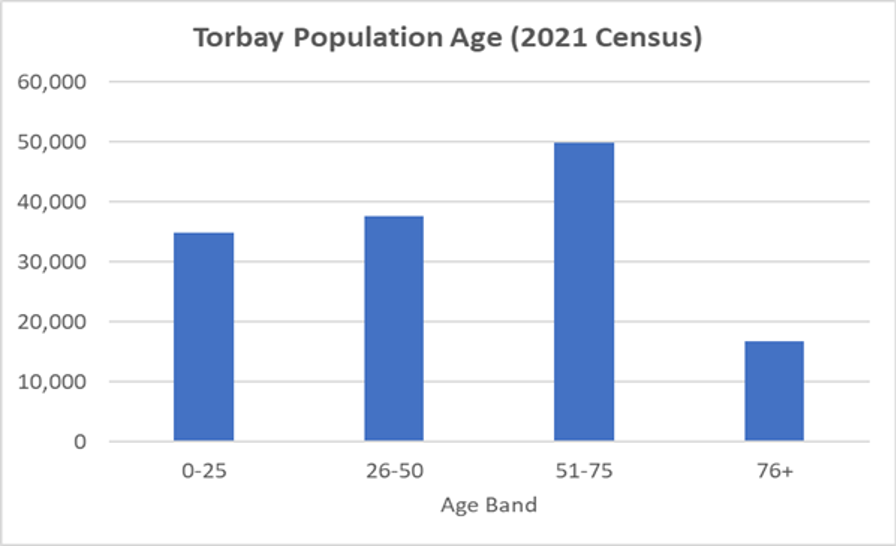
Youth Violence in Torbay
Following analysis of data in respect of youth violence in Torbay that has been provided by the Torbay Youth Justice Service and Devon and Cornwall Police some key points have been determined:
- There is a higher rate of violent offences per 1000 population in Torbay than the national average, and a higher rate of hospital admissions due to violence, including sexual violence.
- There is a higher rate of hospital admissions due to substance misuse (which is significant given the links between violence and alcohol misuse as outlined later in this document).
- Violence against the person is the highest category of offences by young people in Torbay.
- The data relating to youth violence suggests a spike around the ages of 15-17. Although there is an emerging trend of younger children becoming first time entrants into the youth justice system (as outlined in the ‘emerging themes’ section below).
- The rate of custodial sentences given to Torbay children is consistently below the national and family group average across the country and has remained at zero since 2020. Although this could be seen as positive there can be no room for complacency, as it is often the case that the offence committed by the young person is so severe that it has serious life-long consequences for them and their victim.
- Although there is a spread of violent incidents across the three towns, there are identified ‘hot spot’ areas of Paignton and Torquay which account for the highest number of and or more serious incidents.
- The majority of violent offences recorded are committed by young men. However, there is evidence of an emerging increase in girls committing offences (as outlined in the ‘emerging themes’ section below).
- Children with Education, Health and Care Plans are overrepresented. 32% of children who received an outcome for an offence during 2022 had an EHCP, the comparative figure for children across Torbay is 12%.
- Community resolutions / referral orders are by far the most used outcomes for violent offences.
Emerging Themes in Youth Violence:
At the 12 months ending October 2023, the rate of First Time Entrants (FTEs) into the youth justice system per 100,000 10–17-year-old population in Torbay has been at its highest since April 2020. There were 16 more children entering the youth justice system for the first time in the 12 months to October 2023 than in the same period to October 2022. This continues an upward trend in the number of FTEs in Torbay since April 2023.
The most recently published data is for the 12 months ending June 2023 and Torbay’s rate was 235. The family group average has remained stable and is 161 for the same period. Comparable Youth Justice Services are therefore not seeing the increase in FTE’s currently experienced in Torbay.
Through the data we know that violent offences are the most common offence type linked to FTEs. Although it should be noted that in 2019 that there were a similar number of FTEs due to violent offences, the proportion was not as high: 49% in 2016 vs 57% in 2023. The increase of violent offences committed by FTEs highlights a trend of more serious offences that were not suitable for diversion from the formal Youth Justice System. The table below shows the main offence type committed by FTEs in Torbay.
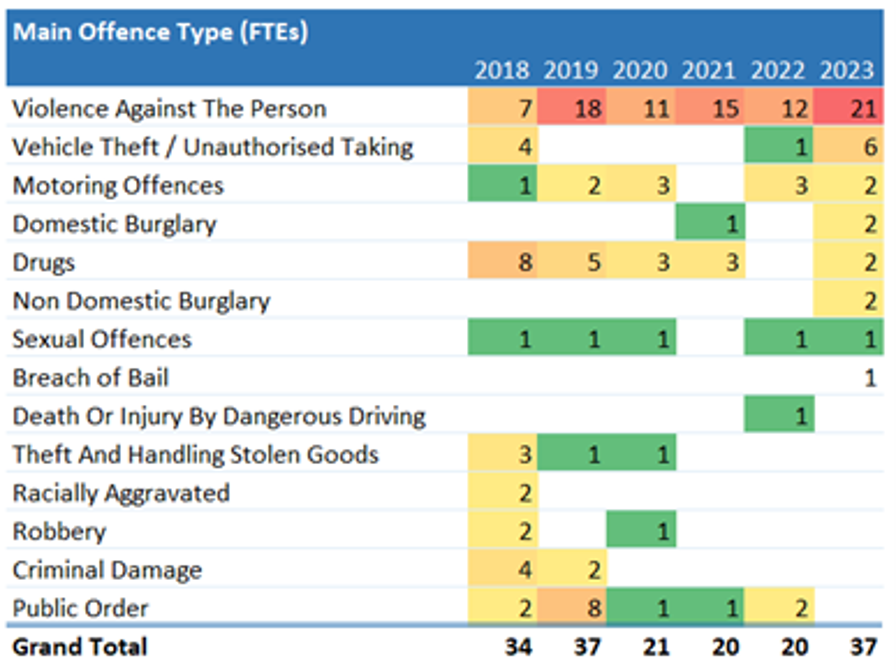
Development of Our Strategy
Our strategy has been informed and shaped by bringing together our strategic needs assessment with existing local and national data and intelligence to enable the development of a partnership approach to effectively address violence in relation to cross-cutting themes and that supports cross-cutting systems planning and delivery.
This includes using national and local research to find what works in reducing violence.
Central to our development is the views and lived experience of our communities which we have gained through engagement activities such as surveys, local partnership meetings and community engagement events to ensure we fully understand local needs including what works.
Our Focus:
In Torbay we are committed to reducing the impact of violence across our communities.
Through consultation with the partners including our communities, it is clear that youth violence in Torbay is becoming an increasing concern. This is supported by the data which clearly shows an over-representation of the under 25 cohort in violent offences committed in Torbay.
This combined with the emerging theme of increases in FTEs in the youth justice system as a result of violence offences and the reduction of age of first-time entrants, has resulted in Safer Torbay ensuring that within this strategy there is a focus on under 25s.
This is in line with the Government’s Serious Violence Strategy 2018 which stresses the importance of early intervention to tackle the root causes of violence and steering young people away from crime in the first place.
It is Safer Torbay’s view that by focusing on early intervention and prevention and continuing to strengthen the collective partnership understanding and response to youth violence we will be able to bring about long-term sustainable change and reduce violence and its impact on individuals, victims, families, communities and businesses.
Review of Youth Violence in Torbay (the Youth Review):
To better understand the Torbay landscape in relation to how children and young people become involved in violence and how those children and children at risk of being involved in violence are supported, Safer Torbay commissioned Peopletoo[4] to undertake a scoping and audit exercise.
The aim of this work was to inform the whole system development and approach to breaking the cycle of youth crime and violence moving forward.
Central to this is understanding the various risk factors for youth violence. Having a clear understanding of cohorts most at risk and drivers of youth violence is key to developing an effective partnership response to both address violent behaviour in the here and now, but also look “upstream” to how we may reduce those risk factors to achieve long-term sustainable reduction in violence and improve outcomes for individuals’ families and communities.
Drivers:
To effectively address violence, we need to understand what drives it. The Youth Review brought together local and national data and research with the views of the local communities, young people and partners to identify the main drivers of violence in Torbay.
The overriding themes were:
- The impact of poverty, deprivation and the presence of multiple risk factors, and the link to exploitation that this can bring.
- Violence or aggressive behaviour as a response to experiencing trauma and abuse (including the difficulties in regulating emotions).
- Normalisation, extreme bullying and poor awareness of the impact of violence.
- Perception of fear / violence as a form of self-defence.
- Boredom and the link to alcohol misuse and group / gang behaviour.
-
Poverty deprivation and multiple risk factors:
There is a clear link between youth violence and deprivation. Local data and national research shows those involved in violence are more likely to be experiencing wider social impacts of deprivation within both the home and community.
The report by Devon and Cornwall Police in 2021[5] supports this by stating that young people who offend or become involved in violence often have multiple risk factors, with exclusions, unmet speech, language and communication needs, wider education disadvantage, mental health and substance misuse concerns mentioned as key factors by stakeholders. These are all risk factors associated with poverty, deprivation and low aspiration.
It is noted that a young person can be affected by more than one risk factor at any given time, which makes an individual even more vulnerable to being engaged in different types of violence either as a perpetrator or as a victim. The pathway to violence is therefore often complex and multifaceted, at an individual, relationship, community and societal level.
-
Violence linked to experience of trauma and abuse:
Linked very closely to the impact of deprivation is the clear link made between violent / offending behaviour and the experience of trauma in early life, in particular either witnessing or being a direct victim of domestic abuse.
Evidence from the Torbay Youth Justice Service and other services that work with young people involved in offending / violent behaviour, stated very clearly when interviewed that this was the most causal factor in cases seen. In other words, in every case where offending / violent behaviour was seen, the young people had been the victim of some form of trauma in the home in their early years, primarily domestic abuse or a high level of parental conflict.
Many were manifesting behaviours that reflected the poor mental health that they now experienced which impacted on how they respond to the world around them, namely in a way that reflected that they were accustomed to feeling under threat, and their difficulties in regulating their emotions. This is being seen more and more in younger, primary aged children, especially the cohorts who missed out on early socialization during COVID 19 lockdowns, and an increasing rate of permanent exclusions amongst this age group.
Understanding this is key to considering how we may reduce youth violence more indirectly by reducing the factors that underpin it. With the shift towards violent behaviour being seen in younger children, it emphasises the need for primary settings to be skilled in managing this and having access to support.
-
Normalisation, extreme bullying and poor awareness of the impact of violence.
As part of the Youth Review, many incidents were shared of violence which occurred but were not reported. Some of these had occurred as an escalation of bullying that ended up in a physical confrontation or an aggressive stealing of property.
The Youth Review heard that there had been little awareness of the harm that such incidents can have on the victim, until they had taken place and a restorative justice response had been implemented.
Some of this escalation/lack of awareness is thought to come from the normalisation of violence in media e.g. films, video games, social media, where the act of violence is seen as normal, almost glamorous, but rarely shows the harmful consequence.
Supporting young people to understand that this is not normal, and what these consequences are, may go some way to reducing the risk of violent and bullying behaviour. It is also important that we empower young people to acknowledge that what they may be experiencing by way of the threat or reality of violence is not right, that they do not have to put up with it and provide a way for them to ask for help.
Linked to this, the normalisation of violence in relationships continues to be a concern, with the rise of the viewing of extreme and explicit pornography being seen as a key causal factor in sexual violence by young people.
-
Perception of fear/violence as a form of self-defence:
Through the consultations with communities including with young people, a lot of feedback has been received about people’s perceived fear for their safety in many parts of Torbay, which prevented them from accessing the community as much as they would otherwise wish to, or at certain times.
In relation to young people worryingly, many partners talked of the normalisation of carrying knives as a form of self-defence. Much of this was due to a young person feeling the need to protect themselves; some of this was borne out of a perceived threat of violence through the anecdotal evidence of their peers, but it is likely that some of it could also be traced back to a response to trauma that makes them feel that they are constantly in fear of attack.
Either way, this normalisation of carrying knives begins to exacerbate itself and adds a worrying dimension to youth violence, because the concern is that simply carrying such a weapon (generally a knife) could lead to prosecution, or, even worse if it was used in response to a situation, the consequences become much more serious.
Some young people stated that they had used violence when they had felt under threat from confrontation, sometimes from adults under the influence of substances who were being threatening towards them in a public place.
The perception of fear is an interesting one, as it may not always be easy to prove one way or another whether this fear is justified e.g. whether it is based on evidence that if you go to a certain place / at a certain time you experience a genuine threat, or whether it is the fear itself that perpetuates itself, sometimes fuelled by rumour or other people’s fears.
Furthermore, as Torbay is a small place where high-profile incidents occur, they can seem more significant, which creates a feeling that there’s more than there actually is. How these incidents are managed from a communications and media perspective when they do occur is therefore crucial.
-
Boredom/links to alcohol misuse:
Some of the young people who were spoken to as part of the Youth Review cited boredom and lack of positive things to do as a causal factor for violence.
Young people shared not that violence was seen as an activity to relieve boredom, but that boredom can lead to excessive alcohol consumption in groups, often in public spaces where other groups may be gathered, which can lead to tension and an escalation into violence.
Linked to this, boredom from lack of constructive activity especially when linked to poverty, low aspiration and a skewed view of male role models, risk drawing young people into exploitation. For example, the drugs industry/county lines and the violence that can come with this.
Our Strategy
Principles and Approach
Our strategy is underpinned by 6 key principles. These principles act as the foundations of the partnership development and response to serious violence at both a strategic and operational level.
It is important to note that these principles are not hierarchical, and all play a crucial role in ensuring an effective response to serious violence. As the partnership evolves, we expect these principles to evolve with it, including additions to ensure that our approach remains impactful and supportive for our communities.
While often regarded as simply a criminal justice matter, violence is a significant public health issue.
The public health approach recognises that violence, rather than being a result of any single issue or cause, is influenced by many factors. It considers the wider determinants of violence or drivers of violence that can increase an individual's risk of being involved in violence either as the harmed or harmer.
In line with the Serious Violence Duty, in developing our strategy and approach, we have adopted the World Health Organisation’s (WHO) public health model of violence reduction[6].
In summary the approach is as follows:
- Focussing on a defined population
- With and for communities
- Not constrained by organisational or professional boundaries
- Focussed on generating long-term as well as short-term solutions.
- Based on data and intelligence to identify the burden on the population, including any inequalities
- Rooted in evidence of effectiveness to tackle the problem.
The public health approach uses an ‘ecological framework’ based on evidence that no single factor can explain why some people or groups are at higher risk of interpersonal violence, than others. This framework views interpersonal violence as the outcome of interaction among many factors at four levels—the individual, the relationship, the community, and the societal.
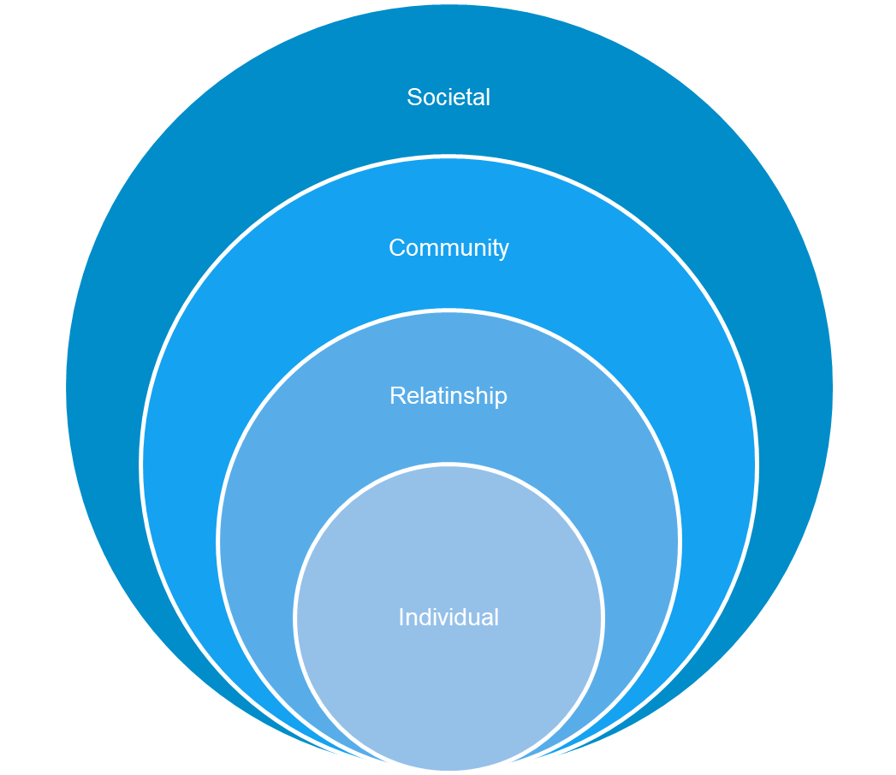
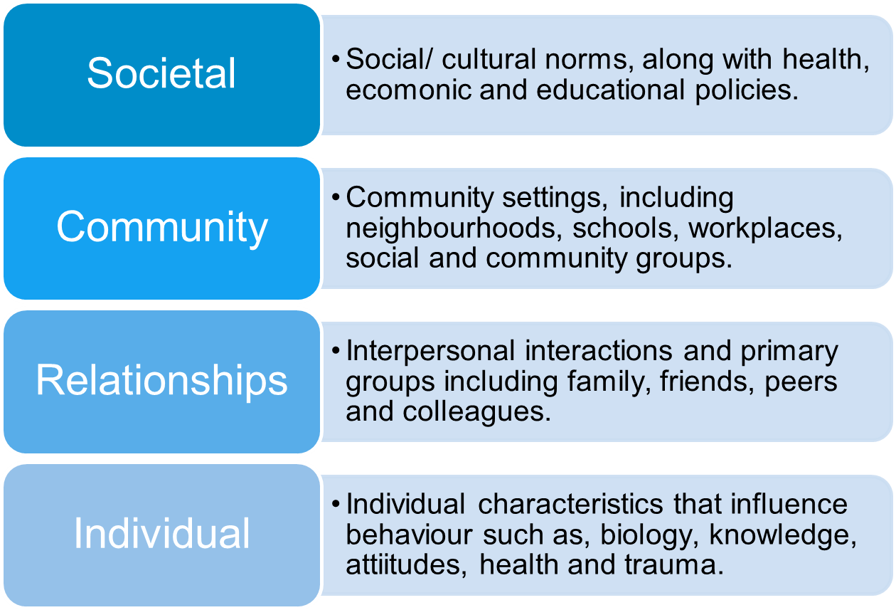
Like people systems cannot be compartmentalised. Each section of the system is part of the whole. If something happens in one part of the system other parts will also be affected, whether that be in a positive or negative way. The relationships and interactions between the individual elements of the system are vital to enable the whole system to function to provide positive impact and benefit to the communities it serves.
Reducing violence requires the knowledge, skills and commitment that goes beyond one agency, profession or community, as such an integrated whole system approach is needed that brings together statutory, non-statutory and community partners to jointly take ownership and develop our approach to preventing violence.
As part of this it is important to note that this strategy is not the single response to violence in Torbay, it is part of a collective that aims to reduce the incidents and impact of multiple harm types across the continuum of need. This strategy does not aim to replace or replicate other crucial work being delivered by the partnership. It aims to continue, extend and support this work and should be read in the context of the collective partnership aims, objectives and responses.
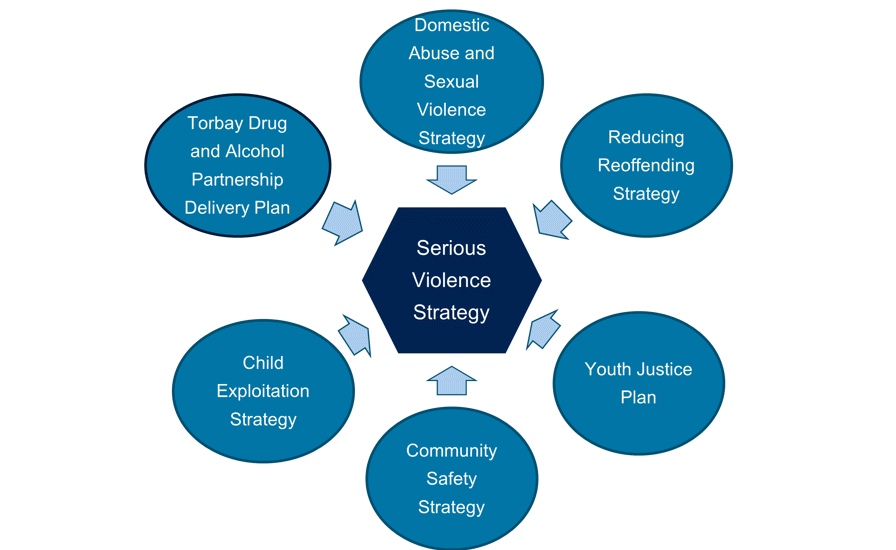
‘Individual trauma results from an event, series of events, or set of circumstances that is experienced by an individual as physically or emotionally harmful or life threatening and that has lasting adverse effects of the individual’s functioning, and mental, physical, social, emotional, or spiritual wellbeing.’ Substance Abuse and Mental Health Services (SAMHSA, 2014a)’[7]
A trauma informed approach recognises the prevalence of trauma in people’s lives and acknowledges the potential effects that this can have on individuals and their families, networks, and communities.
Individuals who have experienced trauma are more likely to experience challenges in relation to physical and mental health, and be vulnerable to experiencing violence, exploitation and abuse.
This is a strengths-based approach and seeks to understand and respond to the impact of trauma. This approach emphasises physical, psychological, and emotional safety for everyone and aims to empower individuals to re- establish control of their lives.
As such, this is a key approach to understanding and addressing violence in our communities in a sustainable way that supports individuals, families and communities.
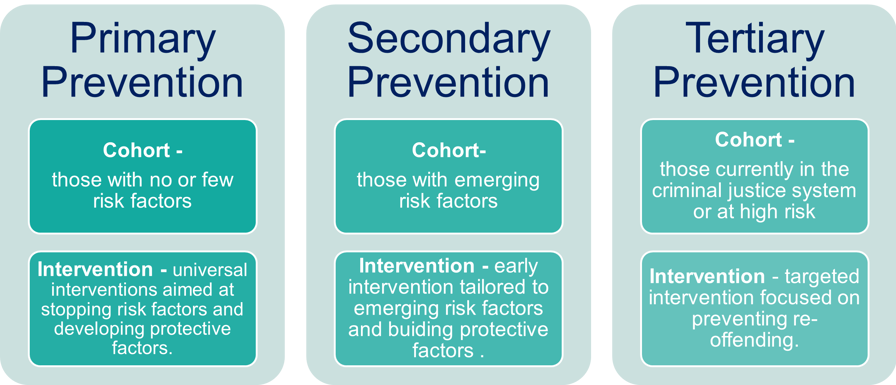
This approach enables us to prevent violence at the earliest opportunity by identifying and preventing the social determinants of serious violence, to early identification of those at risk of being involved in violence and putting in appropriate interventions to prevent this; through to working with those who have committed serious violence to prevent re-offending to reduce the harm and impact of harm to all those impacted.
Engaging, building trust with and collaborating with communities in Torbay is vital to addressing violence and the causes of violence.
Local people are experts of their own neighbourhoods, providing valuable understanding into the trigger points for tensions and violence.
Ensuring communities are involved from the beginning also ensures long-term sustainability of our approach. This means empowering our communities, whether through offering forums for people to share concerns, exchange ideas and build networks, providing training to build on strengths and develop knowledge and skills in the community or exploring funding options to implement initiatives.
By educating local people on violence reduction and equipping them with the tools to engage their networks, we will uplift communities to work alongside us in:
- preventing serious violence before it occurs through provision of positive opportunities and education.
- minimising and containing the impact of violence on the wider community.
- supporting those at-risk of or affected by serious violence, including children, family and friends.
- developing and promoting positive alternative opportunities, away from violence, within the community.
Below are the key principes to this approach:
- Equality: no one person or group is more important, everyone is equal, and everyone has assets to contribute.
- Diversity: we will work to ensure all are included / represented.
- Accessibility: we will ensure everyone is enabled to take part and work to remove barriers to this.
- Reciprocity: we will ensure all community engagement is a two-way process providing benefits for all involved e.g. relationships, learning, improved services.
Torbay has strong and committed statutory and community partnerships that develop and deliver a range of initiatives, services and responses to addressing violence.
Using a strengths-based approach we will build on the existing assets, resources and knowledge of what works, to develop and sustain a long-term, sustainable approach to reducing violence in Torbay.
Our Vision:
Our ambition is to achieve long-term sustainable change that brings an end to violence in Torbay enabling everyone living, working or visiting Torbay to feel and be safe.
Using the data, information, evaluation and research collated to inform this strategy, Safer Torbay has identified 4 key priorities that will underpin partnership work moving forward to achieve this vision. Please note that the listed activity under each principle is not exhaustive but seeks to provide examples of the work that will be undertaken.
Each priority and its supporting activity is, and will be underpinned by the guiding approaches outlined above. A delivery plan providing the detail of how we will achieve these priorities will sit below this strategy and will evolve over the life of the strategy in response to newly identify needs and evidence of what works that is developed at local and national levels.
Our Priorities:
- Develop and deliver sustainable prevention responses across the continuum of need.
- Support and embed attitudinal and behavioural change.
- Develop and implement innovative approaches to criminal justice responses.
- Strengthen and improve whole system understanding of data and effective responses.
Our aim:
- To prevent violence before it occurs.
- Reduce risk factors where they are identified.
- Prevent re-offending.
To achieve this, we will:
- Continue to develop our understanding of ‘what works’ locally and resource and expand implementation and learning.
- Strengthen our cross-system understanding and approach to contextual safeguarding.
- Build on our existing strengths and assets in our community including our youth offer and family hubs.
- Develop responses based on the needs and experiences of individuals and communities using an evidence-based approach to ensure achievable, relevant and sustainable outcomes.
- Use local knowledge, data and intelligence to inform more targeted responses where increased risk factors are identified.
- Integrate restorative approaches across the continuum of need.
Our aim:
- Challenge and sustainably change attitudes and behaviours which foster serious violence at an individual, relational, community and sociality level.
- Improve feeling of safety in the community.
To achieve this, we will:
- Advocate that everyone has a role in reducing violence.
- Engage children, families and communities to better understand their perceptions and fears around safety in their community to understand the drivers and evidence base that underpins them.
- Develop a consistent understanding in communities, education settings and services of what violence is, the impact of violence and the role media/ social media has on the normalisation of violence.
- Empower children, families and communities to build on strengths and develop the knowledge and skills to act and make change.
- Create opportunities to hear and learn from people and communities with lived experience.
- Understand and challenge resistance to change.
- Develop communications strategy and approach to serious violence.
Our aims:
- To disrupt harmful behaviour.
- To reduce the opportunities for serious violence offences to be committed.
- Ensure access to swift and visible justice.
To achieve this, we will:
- Embed multi-agency mechanisms to identify and disrupt individuals at risk of or causing serious violence.
- Embed timely pathways to provide intervention and support to both those that experience harm and those who cause harm.
- Develop clear diversion pathways to provide opportunities for children to engage in positive activities.
- Embed asset-based policing to co-produce better outcomes in communities.
- Ensure consistent and co-ordinated knowledge and approach to victim support, including access.
- Develop pathways and processes that support swift access to justice for those who cause or experience harm.
- Support innovative development and delivery of multi-agency enforcement activity that is focused on an identified problem profile.
- Develop and collectively resource innovative evidence-based multi-agency enforcement activity using appropriate civil and criminal legislation.
- Broaden multi-agency work with probation and prisons to change outcomes for those who cause serious violence.
Our aims:
- To develop multi-agency understanding of the local causes and responses to serious violence.
- Develop a clear evidenced- based understanding of what works to reduce serious violence.
- To successfully implement what works across the system to maximise impact and outcomes.
To achieve this, we will:
- Develop the evidence-base to understand the prevalence, challenges and needs experienced locally.
- Develop a collective understanding of ‘what works’ using local knowledge and national research and use this to implement system change.
- Ensure effective pathways and processes are in place for the timely sharing of information to understand and respond to local issues and needs.
- Establish consistent data collection and monitoring to support the whole system understanding and response to serious violence.
- Develop a clear evaluation framework to quality assure the impact of system responses to serious violence in relation to individuals, communities and families, including the experience and impacts on individuals, whether they have experienced or caused violence.
Governance and Next Steps:
Safer Torbay is responsible for overseeing this strategy and the development and delivery of the action plan that underpins it.
Safer Torbay will work with other key partnership boards and stakeholders (including communities) to ensure that the strategy supports the collectively identified needs, aims and responses ensuring a sustained commitment to the integrated whole system approach.
In the first year of this strategy a whole system delivery plan will be developed and ensure:
- that existing activity is visible to the whole system to avoid duplication or gaps in delivery.
- the actions and outcomes aimed for as part of this strategy are integrated into the part of the system that best enables successful delivery.
- that actions and activities that currently do not have a response are captured and workstreams expanded or developed to encompass them.
[1] Home Office – Serious Violence Strategy, April 2018 (publishing.service.gov.uk)
[2] Police, Crime, Sentencing and Courts Act 2022 (legislation.gov.uk)
[3] Serious Violence Duty - Statutory Guidance (publishing.service.gov.uk)
[4] Peopletoo - Practitioners in Service Design and Implementation
[5] Best practice in violence prevention: an accessible guide to support the Board’s Strategic Priorities; Devon and Cornwall Police, August 2021
[6] Violence Prevention Alliance Approach (who.int)
[7] SAMHSA - Substance Abuse and Mental Health Services Administration
More in Safer Torbay
- Travel Guardian
- About Safer Torbay
- Campaigns we support
- Report a crime or concern
- Support and Training
- Castle Circus and Harbourside Improvement Programme
- Domestic Abuse and Sexual Violence Strategy 2023 to 2030
- Torbay’s Safety of Women at Night Charter
- Prevent: Violent Extremism and Terrorism
- Safer Streets Paignton
- Preventing Serious Violence
- Modern Slavery and Human Trafficking
- Operation Town Centres
- County Lines
- Tombstoning
- Hate Crime
- Support Your Community - Report Concerns